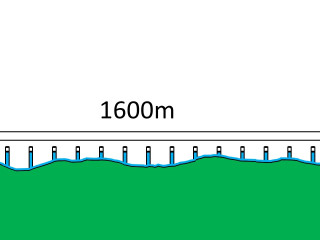The video could be used to introduce the idea that water doesn't really bend as if it were a single, solid piece of plastic. Water is a liquid. Each water molecule in the ocean is seeking its local level.
Better?
I've been reading the comments. I saw the objection, as I thought I would, that this means nothing because the ground isn't really level. It's as if the water level in a section of vertical tubing would be a foot higher if you put a foot tall box under that section.
It would make no difference if a 20-foot deep trench were dug out for 50 yards around the center station, the water level of the center station would remain exactly where it is, about an inch higher than the first and last station, because it's following the geoid!
These 3 columns of water are showing where the geoid is. That's all there is to it. Maybe they're AT the geoid, or maybe they're
above or
below it, but in any case, they are following the shape of the geoid. They are all 3 equipotential water surfaces with approximately the same ambient air pressure, humidity and temperature, because they are fairly close to each other; and the fact that they're connected by the hose means they have the same water pressure. If there were 100 more columns connected in between them, they would gradually rise up to a maximum and then fall back down at the far end, much like these 3 do, and perhaps exactly like these 3 do (the one at 500 m being the highest). But it's possible you'd find the true high point to be a few inches or a few feet closer to the beginning or the end. Having the middle station at 500 meters is probably just fine.
I should point out that it's possible, if there were an
anomaly here, that all 3 glasses
could show the same water level or very nearly the same, like 1/4" different or 3/8" or whatever. That would be because of a gravitational irregularity underground that's causing the geiod to have a flat spot, or at least, some
anomaly that makes it
appear, by these 3 locations, to be a flat spot here. The geoid is not a nice, smooth sphere, but an irregular, lumpy oblate spheroid. Some such anomaly might be going on at lake Balaton, for example, or at the Hawking's "Genius" video lake (the location of which curiously was never identified). In such a case, an open body of water above such anomaly would appear to have a flatish area on the water surface, or perhaps a HUMP. But normally, over a 1000 m distance like this we should expect to find the center glass column water surface an inch or so higher than the other two. No surprise here, because it conforms to the expected curvature of the earth.
It seems to me there is no cause to find some way of explaining this by saying "water doesn't bend." That is one of the false canards of flat-earthers and it has no value or relevance. It's simply bogus. It serves no purpose to pay obeisance to their nonsense. Just like it does nobody any good to say, "the horizon rises to the eye level of the observer," because it
doesn't. The horizon stays
right where it is. Period. The truth is what one should stick to, and in this case the truth is,
under one atmosphere of ambient pressure (more or less) AND a not-unpleasant temperature, water conforms to the shape of its container, and in this case, its container is the hose, the 3 column glasses and the OPEN CHANNEL surface that is defined by proximity to the geoid. Simple!
Open Channel is a standard engineering term. A fluid mechanics engineer would say these 3 column surfaces have
"the same head." Head means the potential distance above (or below) the geoid, or relative to some other elevation of water. Open Channel even applies to moving water, such as in an aqueduct, but it also applies to a lake without any appreciable movement, and that is what we have here. We have basically a lake with stagnant water, emerging in three places and connected by a static subsurface continuum of garden hose. It is a quasi-closed system: closed all over
except at the 3 open surfaces where the column glasses are.


